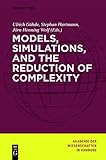Models, simulations, and the reduction of complexity / edited by Ulrich Gähde, Stephan Hartmann, and Jörn Henning Wolf.
Material type: TextSeries: Abhandlungen der Akademie der Wissenschaften in Hamburg ; Bd. 4.Publisher: Berlin ; Boston : De Gruyter, [2013]Description: 1 online resource (viii, 274 pages .)Content type:
TextSeries: Abhandlungen der Akademie der Wissenschaften in Hamburg ; Bd. 4.Publisher: Berlin ; Boston : De Gruyter, [2013]Description: 1 online resource (viii, 274 pages .)Content type: - text
- computer
- online resource
- 3110313685
- 9783110313680
- 501 23
- Q175.32.C65 M63 2013
Includes bibliographical references and index.
Print version record.
Ï»¿Preface; Contributors; Content; Introduction; Cosmology -- The Largest Possible Model?; The Standard Model of Cosmology as a Tool for Interpretation and Discovery; Patterns in Physical and Biological Systems; Symmetry and the Explanation of Organismal Form; Pluralistic Modeling of Complex Systems; The Methodological Challenges of Complex Systems; Contested Modeling: The Case of Economics; A Unifying Approach to High- and Low-Level Cognition; High-vs Low-Level Cognition and the Neuro- Emulative Theory of Mental Representation.
Evaluating a Computational Model of Eye-Movement Control in ReadingConsidering Criteria for Model Modification and Theory Change in Psychology; Identification of Kinetic Models by Incremental Refinement; Kinetics, Models, and Mechanism; Modeling Complexity: The Case of Climate Science; Chaos, Plurality, and Model Metrics in Climate Science; Subject Index; Author Index.
Modern science is a model-building activity. But how are models contructed? How are they related to theories and data? How do they explain complex scientific phenomena, and which role do computer simulations play? To address these questions which are highly relevant to scientists as well as to philosophers of science, 8 leading natural, engineering and social scientists reflect upon their modeling work, and 8 philosophers provide a commentary.
In English.
Added to collection customer.56279.3 - Master record variable field(s) change: 082

There are no comments on this title.